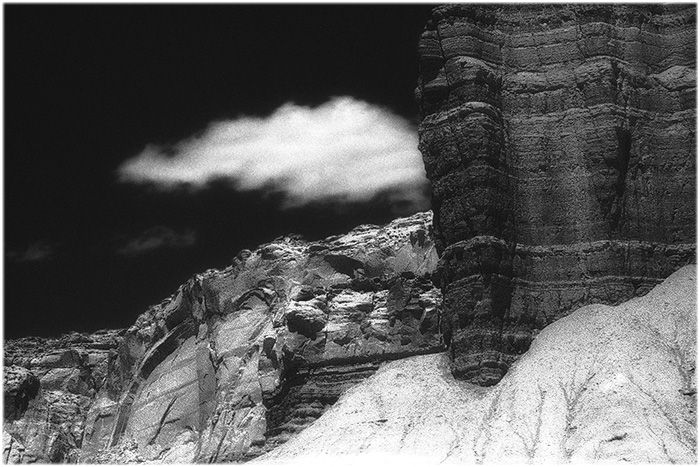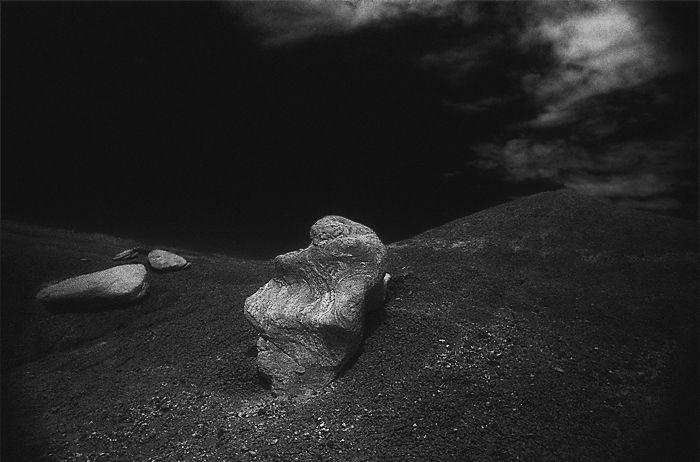blog
Interview with photographer Erv Schroeder
F-Stop Magazine: How did you first become involved in photography and what led to you working in this medium as an artist?
Erv Schroeder: My father loved photography. He photographed the landscape and my mother and me. Hanging in his darkroom were blue ribbons he had won at the county fair. I am an example of the next generation building on the foundation of the previous. Photography has always been a part of my life.
F-Stop: What led to making the “Stone Series”?
Erv Schroeder: In the flow of my life, it was just time for me to make these photographs. “… Spirit always stands still long enough for the photographer It has chosen.” — Minor White
F-Stop: Can you discuss your process for making these images?
Erv Schroeder: My process is two fold. First there is the discovery component. This consists of going to a place like Canyonlands National Park and hiking around until I find something that attracts me. This part of the process is totally chance governed; I feel it is akin to the Surrealists idea of automatic writing. It is the purist form of “I will know it when I see it.”
Second is the equipment and technique. All of the images were made with black-and-white infrared film. I had been using Kodak Infrared film since undergrad school. However, due to the demise of Kodak, I needed a film substitute that closely matched the Kodak look. I switched to Efke Infrared film, but now that is gone as well. Because the Efke film was so slow, I was forced to use a tripod. This changed the way I looked at things, reminding me of my view camera days. Because I couldn’t change film in the field, I used three Nikon F2 bodies and a Nikon D200 digital camera to check the composition. I schlepped all of this equipment in a backpack/camera bag plus the tripod around the desert. Occasionally my girlfriend would also ask me to carry a couple gallons of her water. Of course, I could not refuse. Just call me Sherpa.
The film is processed, scanned and the images are retouched in Photoshop. By retouch I mean digital spotting. There is no image manipulation such as compositing done with Photoshop. Then they are printed with an Epson printer.
F-Stop: What do you hope people see or feel or perhaps learn when they look at your photographs?
Erv Schroeder: It is my belief that art can be contemplative, transformative and transcendent and I hope that viewers of my work will have those kinds of experiences. I also hope that the viewer feels the power of Nature.
F-Stop Magazine: Do you have a favorite image in this series? If so, which one and why is it the image that speaks to you most?
Erv Schroeder: For me it is which one most faithfully represents what I see in my mind’s eye. That image is Dream Traveler. I do not want analyze or demystify the photograph by telling the viewer how to think about it. There are about a dozen photographs, including this one; that I feel I have waited my whole life to make. When I found this place in the Petrified Forest, I knew it was one of those milestone moments—the convergence of my vision and pure luck.
F-Stop Magazine: What are you working on now?
Erv Schroeder: I am working on a couple of related items. The University of New Mexico Press is publishing a book of my Stone Series photographs. The title will be The Memory of Stone and it will be available in late fall of 2014. When I started working the book in 2010, I wanted a book that would provide the reader with a representation of the physical and cultural landscape of the Four Corners. I assembled a book that contains my photographs along with some interesting essays about the landscape and some wonderful poems and prose by Diné (Navajo) and Pueblo writers. In conjunction with the publication of the book, I am working on arranging exhibitions of the photographs.
F-Stop Magazine: What photographers or other artists inspire you?
Erv Schroeder: Photographers are:
Minor White – his work is about transformation and transcendence. I never tire of looking at them.
Timothy O’Sullivan – although best known for his Civil War photographs, I am most interested in the work he did as the photographer for the United States Geological Exploration of the Fortieth Parallel and other expeditions in the West. I love the way he composed his images, showing the beauty and grandeur of an unspoiled land.
Francis Frith – photographed in Egypt and the Middle East during the late 1800s. His photographs capture the monumentality and timelessness of subjects like the Sphinx, almost buried in the sand; and the Pyramids.
The Surrealist painter, Yves Tanguy, is perhaps the strongest influence on my work. I am fascinated by the strange, some say aquatic environment he created that are occupied by strange, anthropomorphic shapes.
The common thread through all of their work is its contemplative, transformative and transcendent nature.
Links:
Minor White, Timothy O’Sullivan, Francis Frith and Yves Tanguy
F-Stop Magazine: What is the best career advice you have ever received?
Erv Schroeder: The best advice I received was never spoken but learned from example. In undergrad school, in addition to photography, I also studied ceramics, as a sculptural media. Paul S. Donhauser Ph.D., was the ceramics professor. During this time Paul was between kidney transplants. You could see how his health was deteriorating while he waited for a kidney to become available. Through it all, he kept teaching and working on his sculptures. He was driven by an inner strength and the indomitable power of his own determination. I watched him develop his ideas. You could see this evolution taking place from one body of work to the next. He was incredibly prolific and a perfectionist. In addition to the clay pieces, he also painted and wrote a book on the history of ceramics. He never said much about mortality, but one time, out of the blue, he did tell me that he had looked death in the face so many times; that he really did not care what anyone thought of him or his work—he knew what he had to do.
From his example I learned self-motivation, determination, the importance of a personal vision and also the nurturing of it over time. I learned about living as an artist from him
Location: Online Type: Interview
One response to “Interview with photographer Erv Schroeder”
Leave a Reply
Events by Location
Post Categories
Tags
- Abstract
- Alternative process
- Architecture
- Artist Talk
- artistic residency
- Biennial
- Black and White
- Book Fair
- Car culture
- Charity
- Childhood
- Children
- Cities
- Collaboration
- Community
- Cyanotype
- Documentary
- Environment
- Event
- Exhibition
- Faith
- Family
- Fashion
- Festival
- Film Review
- Food
- Friendship
- FStop20th
- Gender
- Gun Culture
- Habitat
- Hom
- home
- journal
- Landscapes
- Lecture
- Love
- Masculinity
- Mental Health
- Migration
- Museums
- Music
- Nature
- Night
- nuclear
- p
- photographic residency
- Photomontage
- Plants
- Podcast
- Portraits
- Prairies
- Religion
- River
- Still Life
- Street Photography
- Tourism
- UFO
- Water
- Zine



I enjoyed this interview. It was well conducted and informative. Looking forward to Erv Schroeder’s book and hope an exhibition comes to the Boston area. Minor White and Francis Frith are ALSO on my top favorite list.. an admittedly odd combo, but really liked the insight to this part of Erv’s journey. Thanks for the great interview